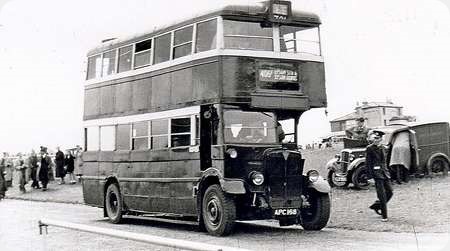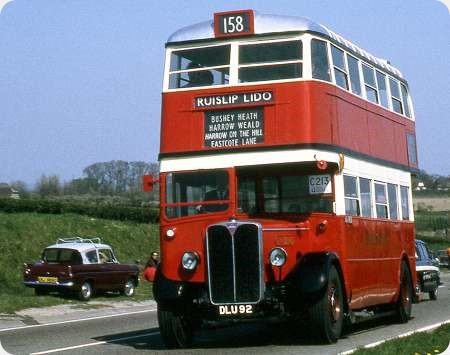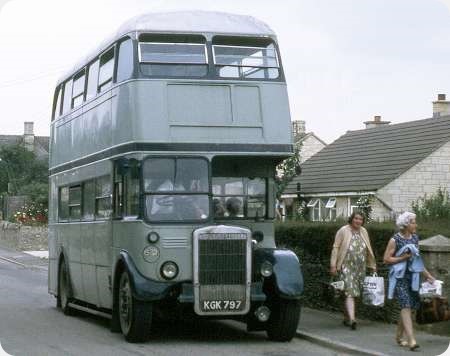
A. H. Kearsey
1949
Leyland 7RT RTL
Park Royal H30/26R
The London Transport RTL class, known to LT as the 7RT, appeared from 1948, and consisted of a modified Titan PD2 chassis frame to accord with features of the AEC Regent RT, enabling the interchangeability of bodywork between the two types. Though fitted with the standard O600 engine, the gearbox was the AEC preselective epicyclic of the RT class, a transmission option that was not a standard offering by Leyland to operators elsewhere. A total of 1631 RTL buses was made, though, as with the 4826 of the RT class, that number never ran together in service. The majority of RTLs had Park Royal bodies, though 32 were originally fitted with Weymann and 500 with Metro Cammell bodywork. To these were added 500 of the mechanically similar eight feet wide RTW class, all of which had Metro Cammell bodies. Under the LT Aldenham overhaul system, bodywork became swapped about between chassis on passing through the works, and tracing individual bodies to chassis during their London Transport lifetimes is complicated. With characteristic profligacy, LT went ahead with developing its new wonder, the Routemaster, from 1954, despite the fact that large numbers of brand new RT and RTL buses were then languishing in store without ever having turned a wheel in revenue earning service. Four years later these stored buses eventually took to the road in 1958, the year before the first production Routemasters began appearing in volume, and they then began displacing the perfectly sound earlier RTLs of 1948/49 after a service lifetime of a mere nine to eleven years, during which full chassis/body overhauls had been undertaken. These withdrawn RTLs, in fine mechanical and body condition, soon found favour with operators at home and abroad (many went to Ceylon) where they rendered years of reliable service. The former RTL 133, KGK 797, delivered to London Transport in February 1949, was sold in January 1959, despite having received a full Aldenham overhaul in 1956, when its original body was replaced with another, also by Park Royal. It was then bought by A. H. Kearsey of Cheltenham, together with RTLs 138/149, KGK 802/813, and all remained with that operator when it was taken over by Marchant’s Coaches in January 1968. In the August 1970 picture above KGK 797, fleet number 62, in Kearsey’s sombre grey and blue livery, is seen (if I recollect correctly, though hesitantly after half a century) in Bishop’s Cleeve. Marchant’s continued to serve this area right up to October 2019 when all its bus routes were withdrawn following issues with Gloucestershire County Council over funding. More Kearsey pictures may be found here:- www.flickr.com/photos/tags/kearsey/
Photograph and Copy contributed by Roger Cox
08/03/20 – 12:29
A minor correction to the details given here by Roger. The 500 Leyland 6RT, RTW class, had Leyland bodies and not Metro Cammell ones.
John Kaye
09/03/20 – 06:32
You’re right John. My error.
Roger Cox
09/03/20 – 06:33
Did some also have Cravens bodies?
Roger Ward
10/03/20 – 06:03
I think that there were some Saunders Roe bodied RT’s as well?
Andrew Charles
10/03/20 – 06:06
The Cravens bodies, as with the Saunders bodies, were on the RT class, A.E.C. Regent III.
RT1402-1521 had Cravens bodies, whilst RT1152-1401 and RT4218-4267 had Saunders bodies.
John Kaye
11/03/20 – 06:25
The bus has generous destination panels, yet, Kearsey left the bus completely ignore every one of them!
Marchant’s Coaches, Cheltenham, are still in fine fettle, with some 7 local school bus services, private hire and mystery tours, and regular day-out tours to places like Legoland. Nice to mention a well-established family concern not in trouble or to announce its demise.
Chris Hebbron
12/03/20 – 06:07
……though they recently pulled out of local service operation, citing too much bureaucracy amongst other issues. Until, I think, the 1980s, they had an amazing network of stage routes around the Cotswolds, worked from a base at Aldsworth, the timings of which they seemed to regard as a state secrets – the recently dropped work around Cheltenham had come from other sources, notably replacing the estimable Castleways when that concern closed.
Phil Drake
15/03/20 – 06:47
Those painted-over destination boxes bothered me as well. I grew up in a place and an era when the buses I saw displayed half a dozen via points on the front, back and nearside, and showed the destination front and back, and even now TfL buses have some route information on the front. So I’m baffled – how did Kearsey’s passengers know where the RTL was going? Was it only ever on one route, which was known to everybody who was likely to use it, or did the conductor shout from the platform “We’re only going to the Town Hall today, love, but we can drop you off at the shops if you like? No sir, we don’t go to the station, not on a Wednesday!”?
Don Davis
Like it, Don; good point well made. Mind you, there were good displays, but confusing ones, too. Portsmouth Corporation, in its middle years, had double-lettered routes. ‘A’ one way and ‘B’ coming back. there was never mention anywhere of this and folk would wait for an ‘A’ return journey and ignore the ‘B,s going by! And this at a seaside resort with lots of holidaymakers. I grew up with suffix letters on route numbers in London, although they never went very high,, but Portsmouth had one route, 143, which went from ‘A’ to ‘F’. ‘A’ was the whole route, then the higher the suffix the shorter the route. Much higher than ‘F’ and the route travelled would have been about a hundred yards!
Incidentally, Cheltenham, which historically only had numbered routes, now has some with letters. I’m surprised that Gloucestershire County Council, which controls bus route numbers, hasn’t forced a change.
Chris Hebbron
16/03/20 – 06:50
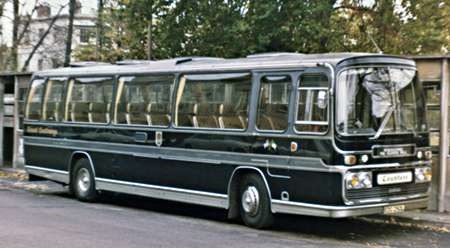
The mention by Phil Drake of Castleways of Winchcombe reminded me of this photo taken in November 1973 of their Leopard PSU3B/4 Plaxton Panorama C49F, apparently named Countess, new in November 1972 looking absolutely stunning in their dark blue and silver grey livery. Taken in Cheltenhams somewhat bleak bus station amongst the autumn leaves.
David Lennard
17/03/20 – 07:07
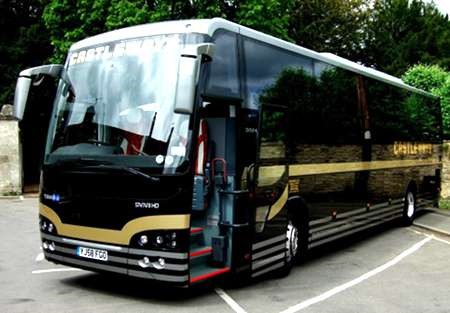
My delight with Castleways was seeing their Temsa Safari coach, which looked absolutely gorgeous in the black with gold band livery. (Photo by R Sharman).
On one occasion, I took their coach on their route to Stratford-upon-Avon. Cheltenham Bus Station, although the late 1940s reinforced concrete shelters have now been replaced by light metal glazed ones, is as bleak, draughty and lacking any comforts as it ever was. Not even a toilet. Perhaps the bus is too uncomfortably reminding them of the Great Unwashed!
Chris Hebbron
18/03/20 – 07:02
They used single deckers on their routes, and the double deckers on schools/factories and as duplicates on stage services.
They were well kept up until Marchants took over. They lost the ladies college work and other work to Castleways and started to go down hill. Marchants was always to be avoided if possible. Its only in the past 20/30 years that Marchants have improved.
A number of years ago Cheltenham and Gloucester used the same numbers, so country routes were adjusted to 3 numbers, and some renumbered, Cheltenham went to letters, Red and White forest routes renumbered.
Mike
19/03/20 – 06:39
Thx, Mike for that info.
Chris Hebbron
19/03/20 – 06:41
Chris Hebbron mentions Portsmouth’s confusing route numbers. Another seaside resort determined to baffle holidaymakers was Southport. Most routes were cross-town, and the route number went with the destination, so if you went from the town centre to Woodvale on an 11, you would return on a 10 bound for Preston New Road. Then when there was a timetable change, the routes would swap partners, and the 11 to Woodvale might return as a 2 to Marshfield!
Peter Williamson
19/03/20 – 06:52
Middlesbrough Corporation Transport used all the letters A – Z. That all changed when TRTB, MCT and Stockton were merged into TMT. Then they moved to numbers, as TRTB and Stockton used numbers. The "O" Bus or "0" ZERO was a joint Stockton/Middlesbrough Bus. 46 and 47 routes later. United then had to add a "2" so the 63 became the 263 to avoid confusion. Then it became Cleveland Transit, a disaster. Then Thatcher scrapped the buses!
Mr Anon
20/03/20 – 06:22
Castleways livery may have looked Black but was Trafalgar Blue.
Tim Presley
21/03/20 – 06:45
As my wife will testify, with a tut and a sigh, Tim, ("Do you think this colour suits me?") I’m colour blind!
Chris Hebbron
21/03/20 – 06:47
Morecambe managed without route numbers until the sixties as did Ledgard until the very end of the company.
Chris Hough
21/03/20 – 06:50
Checked to see if my comment came and then thought no that’s not right it’s Wellington Blue.
Tim Presley
